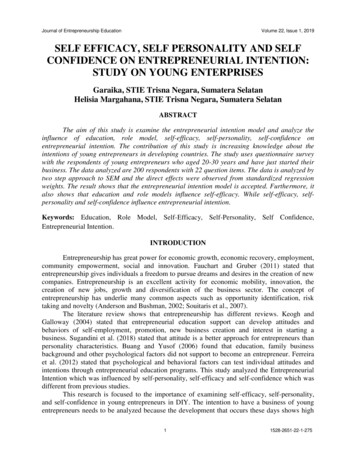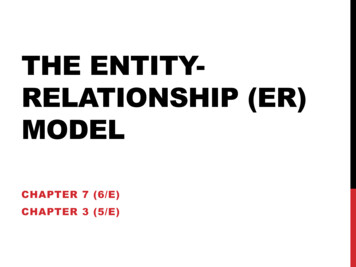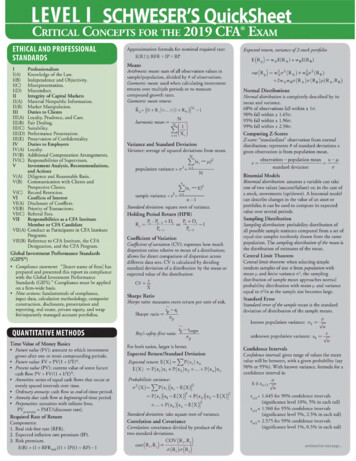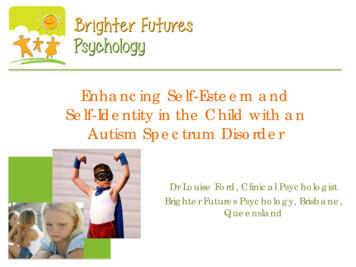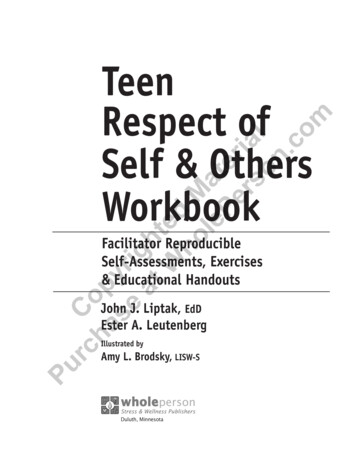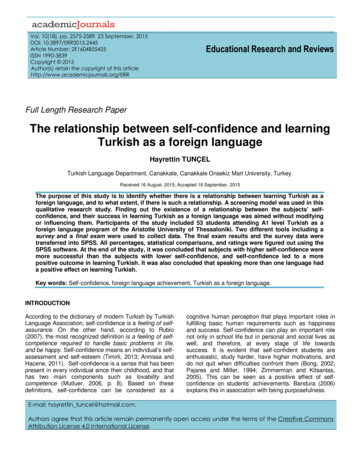
Transcription
Vol. 10(18), pp. 2575-2589, 23 September, 2015DOI: 10.5897/ERR2015.2445Article Number: 2E1604B55425ISSN 1990-3839Copyright 2015Author(s) retain the copyright of this nal Research and ReviewsFull Length Research PaperThe relationship between self-confidence and learningTurkish as a foreign languageHayrettin TUNÇELTurkish Language Department, Canakkale, Canakkale Onsekiz Mart University, Turkey.Received 16 August, 2015; Accepted 18 September, 2015The purpose of this study is to identify whether there is a relationship between learning Turkish as aforeign language, and to what extent, if there is such a relationship. A screening model was used in thisqualitative research study. Finding out the existence of a relationship between the subjects’ selfconfidence, and their success in learning Turkish as a foreign language was aimed without modifyingor influencing them. Participants of the study included 53 students attending A1 level Turkish as aforeign language program of the Aristotle University of Thessaloniki. Two different tools including asurvey and a final exam were used to collect data. The final exam results and the survey data weretransferred into SPSS. All percentages, statistical comparisons, and ratings were figured out using theSPSS software. At the end of the study, it was concluded that subjects with higher self-confidence weremore successful than the subjects with lower self-confidence, and self-confidence led to a morepositive outcome in learning Turkish. It was also concluded that speaking more than one language hada positive effect on learning Turkish.Key words: Self-confidence, foreign language achievement, Turkish as a foreign language.INTRODUCTIONAccording to the dictionary of modern Turkish by TurkishLanguage Association, self-confidence is a feeling of selfassurance. On the other hand, according to Rubio(2007), the most recognized definition is a feeling of selfcompetence required to handle basic problems in life,and be happy. Self-confidence means an individual’s selfassessment and self-esteem (Timirli, 2013; Annissa andHacene, 2011). Self-confidence is a sense that has beenpresent in every individual since their childhood, and thathas two main components such as lovability andcompetence (Mutluer, 2006, p. 8). Based on thesedefinitions, self-confidence can be considered as acognitive human perception that plays important roles infulfilling basic human requirements such as happinessand success. Self-confidence can play an important rolenot only in school life but in personal and social lives aswell, and therefore, at every stage of life towardssuccess. It is evident that self-confident students areenthusiastic, study harder, have higher motivations, anddo not quit when difficulties confront them (Bong, 2002;Pajares and Miller, 1994; Zimmerman and Kitsantas,2005). This can be seen as a positive effect of selfconfidence on students’ achievements. Bandura (2006)explains this in association with being purposefulness.E-mail: hayrettin tuncel@hotmail.com.Authors agree that this article remain permanently open access under the terms of the Creative CommonsAttribution License 4.0 International License
2576Educ. Res. Rev.Bandura suggests that purposefulness has an effect onindividuals with certain purpose to make future plans andhave strategies. High motivation in self-confident foreignlanguage students who can stand firm against anyhardship can be associated with the purposefulnesslinked to their self-confidence in foreign languagelearning.Rubio (2007) in the volume of the book about thecorrelation between the self-confidence and foreignlanguage learning, named Self-Esteem and ForeignLanguage Learning, edited by him mentions that generallytwo topics are discussed in self-confidence studies. Theseare (1) self-confidence; a result of or cause of academicachievement, and (2) the relation between academicachievement and self-confidence. Rubio suggests thatthese studies have different outcomes. It can be claimedthat there is a correlation between competence and selfconfidence. According to Rubio (2007), these twoconcepts are discussed under two titles such as activityand achievement. Some researchers suggest that thereis a correlation between the sense of self-competenceand the cultural background of individuals (Dessi andZhao, 2011; Heine et al. 2001; Kobayashi and Brown,2003). The expectations of the society and the individual’scompetency to meet those expectations can influence thedevelopment of competency. Various factors can lowerself-confidence; for instance, an individual seeing himselfcompetent for a job may hesitate to start the job becauseof his or her low self-confidence.An individual who sees himself competent withlanguage learning might think that he will not besuccessful in the classroom can be considered as lackingin self-confidence. Rubio (2007) states that cognition isthe center of self-confidence, that success or failure is feltcognitively. This brings us to the conclusion that selfconfidence is a sense (cognitive) just like anxiety and fearin humans. Many different factors may lead to anxietyand fear just like many different factors may increase ordecrease self-confidence. Clark’s (1994) study conductedabout low self-confidence provided one of the mostremarkable findings. According to Clark’s study, studentswho live away from their parents for short or long terms,or who have parents who do not show much interest inthem lack in self-confidence. Therefore, the family factorcan be effective on the development of self-confidence inyoung students. Other researchers state that emotionalbonds between students and their parents have effectson the development of self-confidence in them and hindertheir success (Elliot and Church, 1997; Elliot andMcGregor, 2001; Grant and Dweck, 2003). Overprotective parents may hinder the development of selfconfidence in little children. Parents who do not want theirchildren to struggle alone against difficulties may causetheir children to lack in self-confidence, and deprive themof the feeling of success, if they solve all problems beforetheir children. Criticizing children’s personalities, comparingtheir achievements with other children’s achievements,and saying to children “you cannot do it” can beconsidered one of the factors that hinder thedevelopment of self-confidence in children.Self-confidence and foreign language learningIn a number of research conducted by differentresearchers, both positive (Klein and Keller, 1990;Lawrence, 1996) and negative (Roy et al., 2003)correlation between self-confidence and foreign languagelearning were found out. Rubio (2007) explains thissituation by claiming that concept of self-confidence ishard to understand semantically or it can be understooddifferently. Rubio states that self-confidence has bothpsychological and social aspects. Low self-confidencemay have a negative effect on foreign language learningalongside with many other possible themes. According toRubio (2007), low self-confidence may lead to somepsychological conditions such as sense of insecurity,fear, anxiety, and antisocial behaviors. This may be thecase in foreign language learning too. At least, due to lowself-confidence, the student will not be able to make agood start in foreign language learning, because low selfconfidence affects students’ learning motivation (Bong,2008; Pajares and Miller, 1994). An individual who lacksin self-confidence will most probably have a negative biastowards the course and the classroom. A student willhave constant negative feelings like fear of failure, beinginadequate, fear of humiliation, and anxiety towards theteacher and course during the class, and refrain fromspeaking and participating in classroom activities. Lowself-confidence can lead to foreign language anxiety(Bağış, 2007; Gardner and MacIntyre, 1989; Horwitz etal. 1986). The foreign language learning abilities ofstudents lacking self-confidence cannot be revealed.Such students cannot socialize properly and refrain fromspeaking in the classroom.According to Rubio (2007), there is a correlationbetween foreign language learning and classroomatmosphere. Foreign language learning classrooms mustpromote self-confidence. Therefore, creating an environment in which each student will feel self-confident can beconsidered important. The classroom environments inwhich students can answer questions without hesitationexpress themselves without any fear or anxiety of makinga mistake or being humiliated by their teacher even ifthey make a mistake will promote their self-confidence.Therefore, teachers’ behavior, feedbacks, and questionsthey ask to students, and the language teaching activitiesthey are required to take part in are directly correlatedwith their self-confidence.Encouraging students to act and speak correctly, givingthem feedbacks -especially positive feedbacks- instantly,and offering them in-class activities they will enjoy can
Tuncelimprove their self-confidence. Looking at the correlationbetween classroom and self-confidence from Bandura’sperspective (2006), there is a strong correlation betweenan individual’s sense of self-confidence (and selfcompetence) and the social group he is in. People areinclined to think like the social group they are in.Therefore, a student’s sense of self-confidence can bepromoted by other students’ sense of self-competenceand self-confidence in a foreign language learningclassroom with students high in self-confidence.When mentioning the key points of achieving successin foreign language learning, Arnold (2007) emphasizesthat communication among individuals in classroombrings success faster than any material and technique.Ensuring a good communication with students is anachievement of success for foreign language teachers.Only self-confident teachers and students can achievethis success. Self-confident teachers feel comfortable inclassroom, and can convey their messages to studentswithout disturbing them. Their calm and confident natureand actions can promote students’ self-confidence(Krashen, 1982; MacIntyre and Clement 1977; Öner,2008).Self-confidence may help foreign languageteachers communicate with their students, and promotetheir students’ self-confidence. Studies researching selfconfidence (and self-competence) demonstrated thatself-confident teachers could have an effect on theirstudents’ achievements and motivations (Gibson andDembo, 1984; Chacon 2005; Eryaman et al. 2013). Selfconfident teachers are not complex in nature, can createa relaxed classroom atmosphere for their students,entertain their students while teaching a lesson, teach aforeign language without boring them, act carefully not tolower their students’ self-confidence when they need tocorrect their mistakes, and keep students away fromanxieties in classroom, because they do not demand anyperformance beyond their students’ capacities. Therefore,self-confident foreign language teachers can contribute totheir students’ achievements. Achievement of successplays a role in increasing self-confidence. Teachersshould be able to explain clearly what they demand fromtheir students in foreign language classes; in other words,they should be able to explain the purpose of languageprograms clearly. This will help students to relax, andincrease their self-confidence in foreign languagelearning. Some examples of teacher behaviors andclassroom atmosphere that may increase or decreasestudents’ self-confidence in foreign language learning areas follows (Figure 1).It seems that former studies researching the correlationbetween the achievement of learning Turkish as a foreignlanguage and self-confidence were insufficient. This studyaims to fill this gap. The study was on the students whoare learning Turkish outside Turkey (in Greece), and thiscan be seen as an added value, because practicing thelearned language outside the classroom was not2577possible, and the opportunity of testing the effect of thishandicap on the students’ self-confidence for foreignlanguage learning was available.In this study, participants’ general self-satisfactorylevel, their own idea about competence of overcoming awork, and whether they think that their individual abilitiestend to increase with hard work were researched. At theend of the study, these results were compared withparticipants’ Turkish class achievements. To exemplify,Turkish class achievements of students who are alwaysself-confident were compared with those who are notsatisfied with their achievement in the same class.Students’ self-confidence about foreign languages wasalso researched in this study. The state of consideringthemselves as sufficient towards foreign languages,number of foreign languages, and the case of thinkingthat there might be some topics that cannot be learntdespite hard work were researched. Those results alsowerecompared withstudents’ Turkish classachievements. For example, what is the correlationbetween Turkish class achievements of students whoconsider themselves competent about foreign languagesand the achievements of students who do not considerthemselves competent about foreign languages? Thosecases were researched in this study.The purpose of this study is to identify whether there isa correlation between learning Turkish as a foreignlanguage and self-confidence, and in what extent, if thereis a correlation.The research questions to be answered according tothe purpose of the study:a. How are the subjects’ senses of competency abouttheir self-confidence?b. How is the subjects’ self-confidence in learning aforeign language?c. What correlation exists between self-confidence andachieving success in foreign language learning?METHODInformation about the model, population, sampling, data collection,and data analysis used in the study are given.Research designA screening model was used in this qualitative research study.Screening models are the research models aiming to describe apast or present situation as it is/was without attempting to modify, orinfluence them (Karasar, 2012, p. 77). The subjects’ self-confidencewas revealed without modifying or influencing them. The researchwas carried out using a relational screening model. Relationalscreening models are the research models used to find theexistence and/or the degree of covariance between two or morenumber of variables (Karasar, 2012, p. 81). In this study, it wasaimed to identify the correlation between the subjects’ achievementsof learning Turkish as a foreign language and their self-confidence,
2578Educ. Res. Rev.Situation or BehaviorExpected ResultHumiliating students when they make languageDecrease in self-confidencemistakesDecrease in nlanguage learningIncrease in self-confidenceExplaining the language program clearlyDecrease in self-confidenceLanguage teacher’s low level of self-confidenceIncrease in self-confidenceA relaxed foreign language class atmosphereDecrease in self-confidenceA stressed foreign language class atmosphereFigure 1. Examples of behaviors and classroom atmosphere to increase or decrease selfconfidence in foreign language learning.Table 1. Subject distribution according to age and 24 and overTotalf642553%11,379,29,4100Table 2. Subject distribution according to thenumber of foreign languages they speak.Number of foreign language1234 or moreTotalf315211453%5,728,339,626,4100and the extent of the correlation.ParticipantsThe target population of the study included 53 students attendingthe A1 (beginner level) Turkish as a foreign language program ofthe Aristotle University of Thessaloniki in Greece. The researcherwas a teacher teaching Turkish as a foreign language at theAristotle University of Thessaloniki. The study included all studentsattending the A1 level program. All of the students were Greek, andthey were attending various programs at the Aristotle University ofThessaloniki.Table 1 shows the distribution of the subjects according to sexand age. 9,4% of the subjects were men (5 men), and 90,6% ofthem were women (48 women). Majority of the subjects (79,2%)were in 21-23 age group.Table 2 shows the distribution of the subjects according to thenumber of foreign languages they were able to speak. 5,7% of thesubjects (3 subjects) were able to speak only one foreign language,28,3% (15 subjects) two foreign languages, 39,6% (21 subjects)three foreign languages and 26,4% (14 subjects) four or moreforeign languages.Data collection toolsTwo different tools, including a survey and a final exam were usedto collect data for this qualitative research study. The survey wasprepared referring to the article Correlation Study between SelfConcept and Foreign Language Achievement by Anissa andHacene (2011). The questionnaire prepared by the researcher forthe survey was edited by a Turkish Language instructor. For thisreason, an extra pilot data collection was not needed. Thequestionnaire was assessed by two instructors from TÖMER(Canakkale University Turkish Language Center). Finally, thequestionnaire was translated into Greek language by a nativeTurkish speaker, PhD student studying Greek at the AristotleUniversity of Thessaloniki. The subjects were surveyed using thequestionnaire in Greek language.
TuncelSurvey questions were asked to participants to find out the levelregarding their own (a) and their foreign language learning selfconfidence. While first seven items of survey are related toindividual self-confidence (Are you satisfied with yourself in general,to what extent do you think you have good traits, and etc.), otherfive items are about participants’ language learning experiences (Ithink I have ability of learning a foreign language, I am confidentthat I will be successful in foreign languages, and etc. See Annex1).Spelling and dictation of survey questions prepared byresearcher were evaluated and reviewed by Turkish Educationassistant professor at Çanakkale Onsekiz Mart University. Contextevaluation of survey questions was realized by two differentinstructors of Çanakkale University Turkish Language Center.Upon feedback from instructors, a change has been made in theseventh question of questionnaire and “towards foreign languages”statement was added to the beginning of survey item. With its lastrevised version, questionnaire was translated into Greek by anexpert who is studying doctorate at Thessaloniki Aristo University inGreek and whose mother tongue is Turkish. Finally, questionnairein Greek was translated into Turkish by a bilingual undergraduatestudent studying at Thessaloniki Aristo University and it wasassessed by Turkish Language Center instructors both linguisticallyand contextually. Survey in Greek was distributed to participants.The survey included twelve closed-ended questions. Sevenquestions were designed to find out the subjects’ self-confidencetowards their competencies. The other five questions were aboutthe subjects’ self-confidence in foreign language learning (seeAnnex 1). In the first seven questions, the subjects’ were asked (1)if they were pleased with themselves in general, (2) about the goodtraits they thought they had, (3) if they were helpful to others, (4) ifthey thought they were competent in general, (5) if they werecompetent to succeed in anything when they want to, (6) if theythought their individual skills could be improved, and (7) if theysometimes thought themselves incompetent. In the remaining fivequestions which were designed to find out their self-confidence, thesubjects were asked (1) if they liked foreign languages, (2) thenumber of foreign languages they learned, (3) if they thought theyhad competence with foreign language learning, (4) if they wereself-confident, and believed that they would succeed in foreignlanguage learning (2 questions).The second data collection tool used in this study was a 25question final exam. A test designed to evaluate the subjects’achievements in learning Turkish was prepared by the researcherwho was also the course teacher, and the test included the topicsstudied in the course. Upon preparing exam questions, it wasevaluated by Çanakkale University Turkish Language Centerinstructor. Four marks were awarded for each question, and thehighest mark a subject could get was 100.The test included 22 multiple choice; two matching, and onetrue/false questions (see Annex 2).Data AnalysisThe survey data were transferred into the SPSS 15.0. Data wereanalyzed using descriptive analysis. Data analysis was realizedusing percentages, statistical comparisons, ratings and crosstabs.Statistics related to the first and second questionnaire survey items(participants’ general self-satisfactory level, considering themselvessupportive to others, their behaviors towards foreign languages)was shown as depicting frequency and percentage.The third research question of the research is to research thecorrelation between self-confidence and foreign languageachievements of the participants. At this stage, participants’ examaverages, minimum and maximum value of exams were provided.2579Table 3. Distribution according to theanswers to the question “Are youpleased with yourself in general?” askedto the subjects.Are you 00Table 4. Distribution according to theanswers to the question “how many goodqualities do you think you have?” asked tothe subjects.How many qualities?ManySomeVery littleTotalf242953%45,354,7100Exam averages were compared with the participants' questionnaireitems intended for self-confidence with the help of the cross tables.The final exam results were transferred into the SPSS, just like thesurvey data. The survey data and the final exam results werematched to obtain the statistical data and thus all data necessaryfor statistical results were achieved.RESULTSThis section includes the study outcome and findingsassociated with the sub-purpose groups.Findings associated with first research questionFirst research question of the study includes the findingsbased on the answers to the question asked to thesubjects to detect if they think they are self-confidentenough.Table 3 shows the distribution according to the answersto the question “Are you pleased with yourself ingeneral?” asked to the subjects. 37.7% of the subjects(20 subjects) answered that they were always pleasedwith themselves, and 62,3% of the subjects (33 subjects)answered that they were sometimes pleased withthemselves. None of the subjects answered that theywere never pleased with themselves.Table 4 shows that 45,3% of the subjects (24 subjects)thought that they had many good qualities, and 57,7%(29 subjects) thought that they had some good qualities.Table 5 shows that all of the subjects thought they were
2580Educ. Res. Rev.Table 5. Distribution According to theanswers to the question “are you helpfulto others?” asked to the subjects.Are you helpful?YesNoTotalf5353%100100Table 6. Distribution according to the answers tothe question “do you think you are competent?”asked to the subjects.Are you competent?I am incompetentI am competentI am very competentTotalf1233853%22,662,315,1100Table 7. Distribution according to the answers tothe question “I believe that in anything, if I wantto” given to the subjects.I believe that ( )I will absolutely succeedI will not succeedTotalf50353%94,35,7100Table 8. Distribution according to theanswers to the question “I believe that Ican improve my individual skills, if I workhard and practice” given to the subjects.I believe that ( )YesNoTotalf46753%86,813,2100helpful to others.Table 6 shows that 22,6% of the subjects (12 subjects)stated that they were incompetent, 62,2% competent,and 15,1% (8 subjects) very competent.Table 7 shows that 94.3% of the subjects (50 subjects)thought that they would absolutely succeed in anything, ifthey wanted to, while 5,7% (3 subjects) thought that theywould not succeed.Table 8 shows that 86.8% of the subjects (46 subjects)stated that they believed their individual skills can beimproved by working hard and practicing, and sevensubjects stated that they did not think so.Table 9. Distribution according to theanswers to the question “I do/do notthink that I am completely incompetent”given to the subjects.I ( ) think 0Table 10. Distribution according to theanswers of the subjects when they wereasked if they liked foreign languages.Do you like?YesNoTotalf51253%96,23,8100Table 9 shows the responses of the subjects asked ifthey thought themselves completely incompetent. 84.9%of the subjects (45 subjects) stated that they sometimesthought themselves incompetent, 11.3% (6 subjects)stated they never thought themselves incompetent, and3.8% (2 subjects) stated they always thought themselvesincompetent.Findings associated with second research questionSecond research question of the study includes thefindings based on the answers to the question asked tothe subjects “How is subjects’ self-confidence in learninga foreign language?”Table 10 shows the responses of the Subjects asked ifthey liked foreign languages. 96.2% (51 subjects) statedthat they liked foreign languages. Two subjects (3.8%)stated that they did not like foreign languages.Table 11 shows the distribution according to thenumber of foreign languages the subjects were able tospeak. 5.7% (3 subjects) were able to speak one foreignlanguage, 28.3% (15 subjects) two foreign languages,39,6% (21 subjects) three foreign languages, and 26.4%(14 subjects) spoke 4 or more foreign languages.Table 12 shows that 79.2% (42 subjects) thought theyhad competence with foreign language learning. 20.8%(11 subjects) thought they had no competence withforeign language learning.Table 13 shows that 75.5% (40 subjects) did not acceptthat there were subjects they could never learn, no matterhow hard they tried. 24.5% (13 subjects) accepted thatthere were subjects they could never learn, no matter
TuncelTable 11. Distribution according to theanswers given by the subjects when theywere asked the number of foreign languagesthey spoke.Foreign languages1234 ormoreTotalf315211453Table 12. Distribution according to the answers of thesubjects when they were asked if they thought they hadcompetence with foreign language learning.Do you have competence with ?YesNoTotalf421153%79,220,8100Table 13. Distribution according to the responses ofthe subjects to the phrase “I think there are subjectsthat i can never learn, no matter how hard I try”.Some subjects I can never learnYesNoTotalf134053Table 14. Distribution according to the answers ofthe subjects when asked if they hoped that theywould succeed in foreign language learning.Do you have any hope ?I am hopelessI have a little hopeI am very hopefulTotal%5,728,339,626,4100%24,575,5100how hard they tried.Table 14 shows the distribution according to theanswers of the subjects when they were asked “if theyhoped that they would succeed in learning a foreignlanguage”. 88,7% (47 subjects) stated that they werevery hopeful that they would succeed in learning a foreignlanguage. 11,3% (6 subjects) stated that they had a littlehope.Findings associated with the third research questionResearch question of the study includes the findingsbased on the answers to the question asked to thesubjects “What correlation exists between self-confidenceand achieving success in foreign language learning?”Table 15 shows the subjects’ state of being pleasedwith themselves and the Turkish marks averages. Thesubjects who stated that they were pleased withthemselves had higher Turkish marks average (X 93,00)than the subjects who stated that they were sometimespleased with themselves (X 83,06). At the Turkish test,2581f64753%11,388,7100the subjects that have high self-confidence were moresuccessful than the subjects that have low selfconfidence.Table 16 shows the competency and the success ratesin learning Turkish for both groups. The group with themembers who thought they were very competentachieved the highest success in learning Turkish(X 89,00).Table 17 shows that the Turkish marks averages of thesubjects who believed that they were competent tosucceed in anything they wanted to, and the subjectswho believed that they would not achieve any successare very close. No correlation between those twovariables is observed in terms of causality.Table 18 shows the number of foreign languagesspoken by the subjects and their success rate in learningTurkish language. As it is seen in the table the subjectswho were able to speak four or more foreign languagesachieved the highest success rate (X 91,00). Thesubjects who were able to speak three foreign languagesachieved a success rate higher than the subjects whowere able to speak two foreign languages. The subjectswho were able to speak only one foreign languageachieved a success rate of 90 but there were only threesubjects in that category. Therefore, the number offoreign languages learned has positive effects onachieving success in learning new foreign languages.As it is seen in Table 19 the averages of the subjectswho believed that they had competence with foreignlanguage learning, and the subjects who believed thatthey did not have the competence are very close. Nocorrelation between those two variables is observed interms of causality.As seen in Table 20, the Turkish marks average of thesubjects who have the self-confidence to achievesuccess in foreign language learning are higher than theaverage of the subjects who have less self-confidence. Itis observed that there is a positive correlation betweenself-confidence and achieving success in foreignlanguage learning.DISCUSSIONStudies on learning Turkish language and self-confidence
2582Educ. Res. Rev.Table 15. Distribution according to being pleased with oneself and achievingsuccess in learning Turkish.Are you pleased?AlwaysSometimesTotalf203353Average marks93,00083,060Ss4,3405,123
The relationship between self-confidence and learning Turkish as a foreign language Hayrettin TUNÇEL Turkish Language Department, Canakkale, Canakkale Onsekiz Mart University, Turkey. Received 16 August, 2015; Accepted 18 September, 2015 The purpose of this study is to identify whether there is a re

